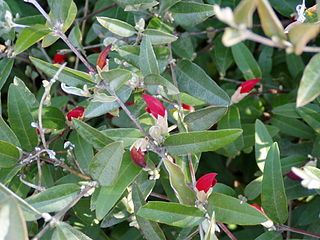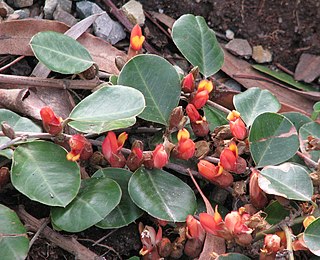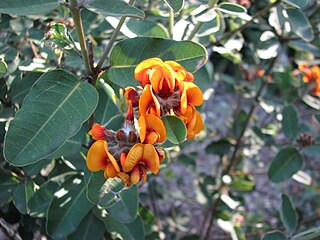
Pultenaea is a genus of about 100 species of flowering plants in the family Fabaceae, and is endemic to Australia. Plants in this genus are shrubs with simple leaves and orange or yellow flowers similar to others in the family but with the standard petal equal to or slightly longer than the other petals.

Gastrolobium is a genus of flowering plants in the family Fabaceae. There are over 100 species in this genus, and all but two are native to the south west region of Western Australia.

Gastrolobium praemorsum is a scrambling shrub which is endemic to the south-west of Western Australia. It is a member of the family Fabaceae and produces red pea-flowers from late winter to early summer. It is not known whether this species shares the toxic properties of many other members of the genus Gastrolobium.

Gastrolobium bilobum, commonly known as heart-leaved poison, is a bushy shrub which is endemic to south west Western Australia.

Gastrolobium celsianum, the Swan River pea, is a low-growing shrub which is endemic to Western Australia.

Gastrolobium sericeum is a flowering plant in the family Fabaceae. It is endemic to the south-west of Western Australia. It is a prostrate, low shrub with pendulous yellow, green, red or nearly black pea-flowers from spring to summer.

Gastrolobium grandiflorum, commonly known as wallflower poison, wallflower poison bush or heart-leaf poison bush, is a bushy shrub which is endemic to Australia.

Gastrolobium spinosum, also known as prickly poison, is a shrub in the family Fabaceae. It is endemic to Southwest Australia
Gastrolobium propinquum is a shrub in the family Fabaceae, endemic to the Southwest Australia savanna region, which is toxic to many animals. It has been given the common name Hutt River poison.

Gastrolobium lehmannii, the Cranbrook pea, is a vulnerable shrub in the family Fabaceae which is endemic to an area of Western Australia.
Gastrolobium rubrum is a shrub in the family Fabaceae. It is endemic to the south west of Western Australia.

Gastrolobium minus, also known as broad-leaved brachysema, is a prostrate shrub which is endemic to the south-west of Western Australia. It is a member of the family Fabaceae and of the genus Gastrolobium, which contains many toxic species, however the toxicity of this species is unknown.

Oxylobium ellipticum, commonly known as the common shaggy-pea, is a flowering plant in the family Fabaceae. It has dense clusters of yellow pea flowers and elliptic-shaped leaves. It grows in south-eastern Australia.

Daviesia corymbosa, also known as narrow leaf bitter pea, is a species of flowering plant in the family Fabaceae native to the state of New South Wales in eastern Australia. A shrub to 2 m (6.6 ft) high, it grows in sandstone soils in open eucalyptus woodland or heath. It produces showy flowerheads of red and yellow flowers in the spring and early summer.

Gastrolobium coriaceum is a shrub species in the family Fabaceae. It is endemic to the south west of Western Australia.

Gastrolobium formosum is a small, trailing shrub, with red flowers, in the pea family (Fabaceae), which grows up to a metre high, on clays and loam in swamps and along river banks. The inflorescence consists of head of four unstalked flowers which is sheathed by a whorl of large bracts, with the flower petals being obscured by the lower calyx lobes. The standard petal is less than on third the keel petal. It is native to the south-west of Western Australia.

Gastrolobium nervosum is a small shrub in the pea family (Fabaceae), native to Western Australia.

Gastrolobium rigidum is a small bushy shrub in the pea family (Fabaceae), native to Western Australia.

Pultenaea elachista is a species of flowering plant in the family Fabaceae and is endemic to southern Australia. It is an erect, spindly shrub with hairy foliage, oblong to egg-shaped leaves with a pointed tip, and yellow flowers with red or orange markings.

Mirbelia seorsifolia is a species of flowering plant in the family Fabaceae and is endemic to the south-west of Western Australia. It is an erect, open shrub that typically grows to a height of 15–70 cm (5.9–27.6 in) and has yellow and red flowers from August to December. It grows on sandplains in the Avon Wheatbelt, Coolgardie, Great Victoria Desert, Murchison and Yalgoo bioregions of south-western Western Australia. The species was first formally described in 1876 by Ferdinand von Mueller, who gave it the name Gastrolobium seorsifolium in Fragmenta Phytographiae Australiae. In 1943, Charles Gardner changed the name to Mirbelia seorsifolia in Enumeratio Plantarum Australiae Occidentalis. The specific epithet (seorsifolia) means "separate leaves", referring to the well-spaced leaves. Mirbelia seorsifolia is listed as "not threatened" by the Government of Western Australia Department of Biodiversity, Conservation and Attractions.


















